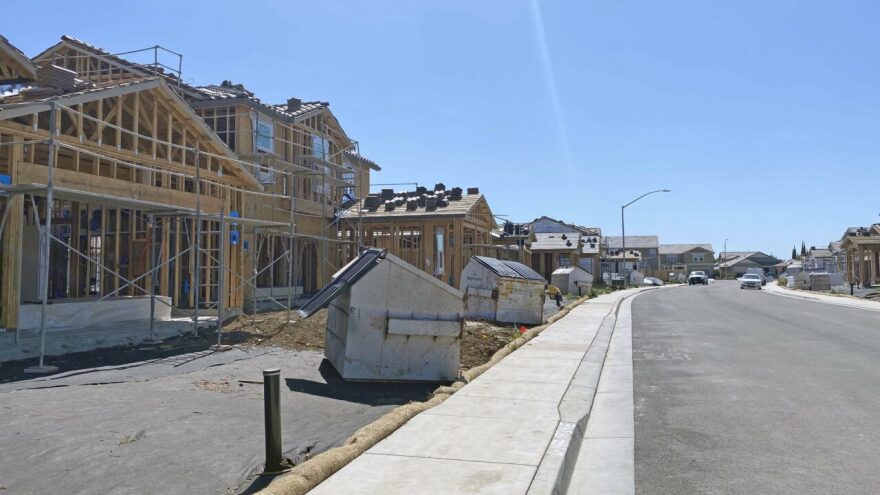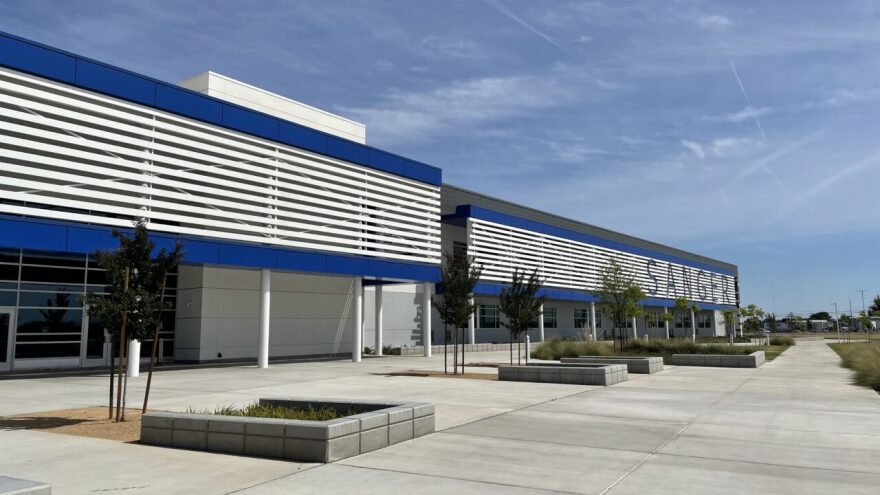This story was originally published by EdSource.
When it was time to put down roots and buy a home for their family, Bay Area residents Mandeep Kaur and Jimmy Singh decided it was time to leave their cramped apartment in Fremont and purchase a home in the San Joaquin Valley.

They landed in Patterson, a small but rapidly growing town of 24,000 off the Interstate 5 freeway. The development they moved into in February is so new that not all the homes on their street have been finished.
Their new home, which, with two stories and a backyard, has plenty of room for their 6-year-old and baby. They like Patterson’s small-town feel.
“There are better schools,” Singh said. “It’s a nice community, not as hectic.”
Patterson is 75 miles from Oakland, which puts it at the outer rim of Bay Area bedroom communities. Singh is freed from the daily commute as the owner of a trucking business who works from home — an increasing trend among recent transplants.
Please refresh your browser if the images don’t properly display.
For decades, the San Joaquin Valley has been a destination for young families seeking affordable housing. Enrollment in the San Joaquin Valley grew 24.5% before the pandemic, and it dipped only 1.1% since 2019.
“We’re very lucky,” said George Bradley, director of research and planning at the Kern High School District. “The alternative is that you’re shrinking.”
The big questions about enrollment in the San Joaquin Valley have been about where new schools will be built, how they will be funded and what to do with the surge of students on campus in the meantime.
But these questions can be thorny. In Patterson, enrollment is spiking with the new developments already underway, and the city is considering approving more. School officials are ringing the alarm, saying that the city is moving too fast and without any consideration for how quickly the district can construct new schools.
Phil Alfano, superintendent of the Patterson Joint Unified School District, told the board that he was “deeply concerned” about the pace of new development.
“I don’t understand the rush. I don’t understand the need to double the size of this community that rapidly,” he said. “It will come, but it doesn’t need to be overnight.”
Affordable housing drives growth
Enrollment fell in the San Joaquin Valley in 2020-21 for the first time in over a decade. But the relocation of California residents priced out of the Bay Area and Southern California continued during the pandemic, pushing up housing prices and rent.
At the height of the pandemic, Michelle Saldana said it was nearly impossible to find an affordable rental. The eviction moratorium meant there were very few vacancies near Whittier, the Los Angeles suburb where her family was living, and the available ones were too expensive. That’s how her family ended up in Bakersfield after casting a wide net and looking at apartments in San Bernardino, Victorville and even Arizona.
“I was so desperate to find a place,” she said.

Valley educators suspected migration was not reflected in 2020-21 enrollment numbers, when many students remained in distance learning.
That was true for Saldana’s family: Her family moved to Bakersfield in February 2021, but her son finished out the year at his Whittier school remotely. This year, her 11-year-old is enrolled at Fremont Elementary in the Bakersfield City School District.
The pace of growth has been dizzying in schools located on the outer edges of San Joaquin Valley in cities where converted farmland is ripe for residential development.
Rapid development outside Fresno has fueled the growth in Clovis Unified, Central Unified and Sanger Unified in Fresno County. Development on Bakersfield’s periphery has made Kern County the Valley’s fastest-growing county. Enrollment has ballooned in the Kern High School District and the elementary school districts that feed into it: Panama-Buena Vista Union, Rosedale Union, Greenfield Union and even parts of Bakersfield City.
Overcrowded school buildings
The greatest challenge in a growing district is facilities stretched past their limits. School administrators say they do everything they can to reduce the impact of overcrowding on students.
Until new schools or new wings are constructed, portable classrooms overtake basketball courts and athletic fields. Lunch hours are lengthened to accommodate all students. Some districts set up food service kiosks outside the cafeteria to prevent long lines inside crowded cafeterias.
Sanger Unified is a vast district that serves not just the small town of Sanger, but Clovis and the rapidly developing southeastern corner of Fresno. Its enrollment grew 58.1% between 2000 and 2019, and it has grown another 4.5% since then.
“The challenge has just been facilities,” said Sanger Unified Superintendent Adela Jones.
One school, Sequoia Elementary, ran out of room for portables on its campus, requiring students to be bused to neighboring schools, Jones said.
Redrawing school boundary lines is another common strategy to ease the most overburdened campuses until another school is built. It can be a fraught process, but this has helped the Kern High School District accommodate its rapid growth.
“Because Kern High is such a large district, it has been able to be flexible and accommodate the growth,” Bradley said.
Last year, drawing boundaries for Del Oro High School turned into an extensive process that involved 13 other high schools and will ultimately affect almost 6,000 students.
“This boundary change took a little bit of pressure off, but capacity is still an issue,” Bradley said.
School construction in California has never been cheap, but the cost of school construction skyrocketed in 2021.
Sanger Unified is constructing a complex in Fresno that will house the district’s second middle school and high school. Plans for a new elementary school in Clovis are on hold due to construction costs.

“The cost of construction is out of control,” Jones said.
Rising construction costs were cited in Jefferson School District’s decision to delay the opening of its newest school in Tracy Hills for another year. Bids for the school in the northern San Joaquin Valley community came in at $54 million, far above the district’s $35 million budget.
When a community is growing, schools must stay ahead of the curve, said Jack Woody Colvard, a management consultant for the Kern County Superintendent of Schools. He helps districts plan their facilities. “I pay attention because I don’t want to see any of them get behind,” he said.
‘Like history repeating itself’
In Patterson, the relationship between the school district and the city and developers recently reached a boiling point. Banners that read “Save Our Schools: Developers Must Pay Their Fair Share” have been put up outside every campus. A group called the Patterson Education Advocacy Committee, which includes district administrators, teachers, staff, parents and students, hosted a rally in front of City Hall last month.

School officials in Patterson Joint Unified and many residents said they are worried about the sheer scale and time frame of what could be coming to a school district with just under 6,900 students.
There are two developments with 3,548 new homes currently in the works, and the city is considering approving two more developments with 5,391 homes. Assistant Superintendent Jeff Menge said that could bring 33,000 new residents and 5,490 students to the schools.
School board trustee Heaven Goins said city officials aren’t being transparent, and they’re not thinking about the impact development will have on residents.
“They’re not educating us as taxpayers — and then we’re wondering why there’s going to be taxes and why schools aren’t built and we’re not getting funds for our students,” Goins said at a public board meeting. “It’s going to impact our next generation — it is — and our staff who is going to have to deal with it daily.”
The school district struggled during the last boom in development. Like other Northern San Joaquin Valley cities, Patterson exploded in population during the area’s last housing bubble of the 2000s.
Patterson residents don’t remember the boom days fondly: Overcrowded elementary schools went on multi-track schedules.
“The year-round was killing us as a family because we had that split. We had kids in high school, junior high and elementary,” said school board trustee Michele Bays. “As a parent, it wore me out.”
City officials have vowed to ensure that developers pay school impact fees, which are set by state statute, but they lament that the fees come too late.
“The development of adequate school facilities for a growing community is of utmost importance to the City,” City Manager Ken Irwin wrote in a statement.
State funding for school construction may soon be available. The Legislature is expected to vote on bills to distribute the remaining $1.4 billion in state bonds and to add $4 billion from the general fund for K-12 facilities.
“We would have to wait until they have built approximately 1,200 homes, and then we’d have to wait three years for a school to be built,” Menge told the city’s planning commission. “I don’t know where those students would be housed.”
In the meantime, the district could return to its unpopular year-round scheduling, or it could even have to pay to bus students to neighboring districts, Menge said.
“It’s almost like history repeating itself,” he said.
A mitigation agreement with developers before the city greenlights a project allows the district to negotiate for upfront funding so that schools can be constructed as a new development is growing. But school officials say that hasn’t happened and that their input on projects has been ignored.
“All that we ask is that [the city] bring us in early, and we can carry the torch for our families from that point forward,” Menge said.
Signs of strain
Patterson Joint Unified is constructing new wings at two of its elementary schools to deal with this wave of new students. The district currently has 6,885 students, which is 671 more than it had in October. That represents a 10.8% jump within this year alone.
Carolina Aguilar said she worries about what will happen when more people move in. She enrolled her son and daughter at Apricot Valley Elementary, but initially, there was only room for her son.
“They’re not going to have room for other kids to be here, so where are they going to go?” she said.
Traffic is bad when school lets out. Even now that both of her children are attending the same school, she arrives an hour before school lets out to pick them up to avoid the crush of cars.

Apricot Valley is one of the schools named in the development plans, but school officials say that the school is already over capacity with 834 students. Menge told the planning commission that new developments could more than double enrollment to 1,900 students.
Space is already at a premium on campus, said Principal Shelby Huerta. The stage in the multipurpose room is now used as a music room, so assemblies are now held outside. Classrooms are packed, too.
Joe Wilcox, a sixth grade teacher, sometimes has as many as 40 students in his classroom during rotations with other teachers, which means that sometimes he has a student sitting at his desk, and kids sitting on the floor.
“You do the best you can for the students, but they deserve better,” he said.

